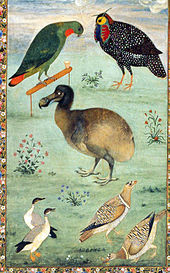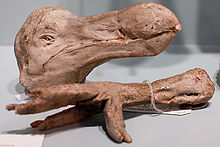- Dodo
-
Dodo
Temporal range: Late HoloceneDodo reconstruction reflecting modern research at Oxford University Museum of Natural History[1] Conservation status Scientific classification Kingdom: Animalia Phylum: Chordata Class: Aves Order: Columbiformes Family: Columbidae Subfamily: †Raphinae Genus: †Raphus
Brisson, 1760Species: †R. cucullatus Binomial name †Raphus cucullatus
(Linnaeus, 1758)
Former range (in red) Synonyms - Struthio cucullatus Linnaeus, 1758
- Didus ineptus Linnaeus 1766
The dodo (Raphus cucullatus) was a flightless bird endemic to the Indian Ocean island of Mauritius. Related to pigeons and doves, it stood about a meter (3.3 feet) tall, weighing about 20 kilograms (44 lb), living on fruit, and nesting on the ground.
The dodo, which was indigenous only to Mauritius, had lost the power of flight because food was abundant and predators were absent. By 1681 all dodos had been killed by the settlers or by their domesticated animals on the island.[3] The extinction of the bird, within 80 years of its discovery, made man realise for the first time that he could induce the extinction of plants and animals.[4]
The phrase "dead as a dodo" means undoubtedly and unquestionably dead, while the phrase "to go the way of the dodo" means to become extinct or obsolete, to fall out of common usage or practice, or to become a thing of the past.
Contents
Discovery and etymology
 Compilation of some of the earliest drawings of the dodo, from the travel journal of the VOC ship Gelderland (1601–1603)
Compilation of some of the earliest drawings of the dodo, from the travel journal of the VOC ship Gelderland (1601–1603)
The earliest known descriptions of the bird were made by Dutch travelers to what is now the island of Mauritius, east of Madagascar. The dodo was known by the name "walghvogel" ("wallow bird" or "loathsome bird," in reference to its taste), first used in the journal of vice-admiral Wybrand van Warwijck, who visited the island in 1598. The bird was also referred to as "dronte" by the Dutch, a name which is still used in some languages. Although many later writings say that the meat tasted bad, early journals say only that the meat was tough but good, though not as delectable as abundantly available pigeons.[5]
In 1606 Cornelis Matelief de Jonge wrote an important description of the dodo and some other birds, plants and animals on the island.[6] He described the dodo thus:
Blue parrots are very numerous there, as well as other birds ; among which are a kind, conspicuous for their size, larger than our swans, with huge heads only half covered with skin as if clothed with a hood. These birds lack wings, in the place of which 3 or 4 blackish feathers protrude. The tail consists of a few soft incurved feathers, which are ash coloured. These we used to call ' Walghvogel,' for the reason that the longer and oftener they were cooked, the less soft and more insipid eating they became. Nevertheless their belly and breast were of a pleasant flavour and easily masticated.[7]
Few took particular notice of the bird immediately after its extinction. By the early 19th century it seemed altogether too strange a creature, and was believed by many to be a myth. In 1848, H. E. Strickland and A. G. Melville published a book titled The Dodo and Its Kindred; or the History, Affinities, and Osteology of the Dodo, Solitaire, and Other Extinct Birds of the Islands Mauritius, Rodriguez, and Bourbon in which they attempted to separate Dodo myth from reality. With the discovery of the first batch of dodo bones in the Mauritian swamp, the Mare aux Songes, and the reports written about them by George Clarke, government schoolmaster at Mahébourg, from 1865 on, interest in the bird was rekindled.
The etymology of the word dodo is unclear. Some ascribe it to the Dutch word dodoor for "sluggard", but it more likely is related to dodaars ("knot-arse"), referring to the knot of feathers on the hind end. The first recording of the word dodaerse is in captain Willem van Westsanen's journal in 1602.[8] Thomas Herbert used the word dodo in 1627,[9] but it is unclear whether he was the first; the Portuguese had visited the island in 1507, but, as far as is known, did not mention the bird. Nevertheless, according to the Encarta Dictionary and Chambers Dictionary of Etymology, "dodo" derives from Portuguese doudo (currently doido) meaning "fool" or "crazy".[10][11] However, the present Portuguese name for the bird, dodô, is taken from the internationally used word dodo.
David Quammen considered the idea that dodo was an onomatopoeic approximation of the bird's own call, a two-note pigeony sound like "doo-doo".[12]
Systematics and evolution
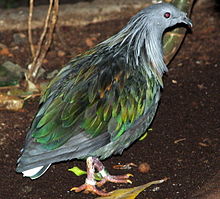 The Nicobar Pigeon (Caloenas nicobarica) is the closest living relative of the dodo and the Rodrigues Solitaire.
The Nicobar Pigeon (Caloenas nicobarica) is the closest living relative of the dodo and the Rodrigues Solitaire.
The dodo was a close relative of modern pigeons and doves. mtDNA cytochrome b and 12S rRNA sequences[13] analysis suggests that the dodo's ancestors diverged from those of its closest known relative, the Rodrigues Solitaire (which is also extinct), around the Paleogene-Neogene boundary.[14] As the Mascarenes are of volcanic origin and less than 10 million years old, both birds' ancestors remained most likely capable of flight for considerable time after their lineages' separation. The same study has been interpreted to show that the Southeast Asian Nicobar Pigeon is the closest living relative of the dodo and the Rodrigues Solitaire.[15]
However, the proposed phylogeny is rather questionable regarding the relationships of other taxa[16] and must therefore be considered hypothetical pending further research; considering biogeographical data, it is very likely to be erroneous. All that can be presently said with any certainty is that the ancestors of the didine birds were pigeons from Southeast Asia or the Wallacea, which agrees with the origin of most of the Mascarenes' birds. Whether the dodo and Rodrigues Solitaire were actually closest to the Nicobar Pigeon among the living birds, or whether they are closer to other groups of the same radiation such as Ducula, Treron, or Goura pigeons is not clear at the moment.
For a long time, the dodo and the Rodrigues Solitaire (collectively termed "didines") were placed in a family of their own, the Raphidae. This was because their relationships to other groups of birds (such as rails) had yet to be resolved. As of recently, it appears more warranted to include the didines as a subfamily Raphinae in the Columbidae.
Description
According to artists' renditions, the dodo had greyish and brownish plumage, a 23-centimeter (9-inch) bill with a hooked point, very small wings, stout yellow legs, and a tuft of curly feathers high on its rear end. Dodos were very large birds, possibly weighing up to 23 kg (50 pounds), although some estimations give a weight of about 10.6-17.5 kg.[17] The sternum was insufficient to support flight; these ground-bound birds evolved to take advantage of an island ecosystem with no predators.
The traditional image of the dodo is of a fat, clumsy bird, hence the synonym Didus ineptus, but this view has been challenged in recent times. The general opinion of scientists today is that the old European drawings showed overfed captive specimens.[18] A 17th century painting attributed to the Mughal artist Ustad Mansur showing a dodo along native Indian birds depicts a slimmer, brownish bird, and is regarded by professor Iwanov and dodo-expert Julian Hume to be one of the most accurate depictions of a dodo.[19] Two live specimens were brought to India in the 1600s according to Peter Mundy, and the painted specimen might have been one of these.[20] As Mauritius has marked dry and wet seasons, the dodo probably fattened itself on ripe fruits at the end of the wet season to live through the dry season when food was scarce; contemporary reports speak of the birds' "greedy" appetite. In captivity, with food readily available, the birds became overfed very easily.
Until recently, the most intact remains, currently on display at the Oxford University Museum of Natural History, were one individual's partly skeletal foot and head which contain the only known soft tissue remains of the species. These remains of the last known stuffed dodo had been kept in Oxford's Ashmolean Museum, but in the mid-18th century, the specimen – save the pieces remaining now – had entirely decayed and was ordered to be discarded by the museum's curator or director in or around 1755. The remaining soft tissue has since been severely degraded, as the head was dissected in the late 19th century, and the foot is in a skeletal state.[21]
Until recently, few associated dodo skeletons were known, most of the material consisting of isolated and scattered bones. Dublin's Natural History Museum and the Oxford University Museum of Natural History, among others, have a specimen assembled from these disassociated remains. A dodo egg is on display at the East London museum in South Africa. Manchester Museum has a small collection of dodo bones on display.
In October 2005, part of the Mare aux Songes, the most important site of dodo remains, was excavated by an international team of researchers. Many remains were found, including bones from birds of various stages of maturity,[22] and several bones obviously belonging to the skeleton of one individual bird and preserved in natural position.[10] These findings were made public in December 2005 in the Naturalis in Leiden.
In June 2007, adventurers exploring a cave in Mauritius discovered the most complete and well-preserved dodo skeleton ever.[23]
The white dodo
The supposed "White Dodo" is now thought to be based on misinterpreted reports of the Réunion Sacred Ibis combined with paintings from the 1600s of apparently albinistic dodos that surfaced in the 19th century. Nauralists like Walter Rothschild assumed these descriptions where of the white dodo as seen in the painting by Pieter Withoos, but that the specimen might have been albinistic, due to the wing tips being yellow instead of black as in the old descriptions.[24]
It now appears that all depictions of white dodos were based on a painting, or copies of it, showing a whitish specimen, made by Roelant Savery in ca. 1611 called "Landscape with Orpheus and the animals". This was apparently based on a stuffed specimen then in Prague; Savery's several later images all show grayish birds, possibly because he had by then seen a live specimen.[25]
A walghvogel(dodo) described as having a "dirty off-white coloring" was mentioned in an inventory of specimens in the Holy Roman Emperor Rudolf II's collection in Prague by David Fröschl in 1607-1611, so if the 1611 painting by Savery, who was contracted to Rudolf II at the time, is based on this specimen, it could not have been from Reunión, which was not visited by Europeans until 1635.[26]
This white bird was later identified from 17th century descriptions and paintings, which did not match the descriptions of solitaries (reclusive non-gregarious large birds) seen by contemporary explorers on Réunion very well – apart from being mostly white. Due to this, some assumed two species (Raphus solitarius and Victoriornis imperialis) co-existed on Réunion (or "Bourbon", as it was called in former times) – one dodo-like, one resembling the Rodrigues Solitaire (Pezophaps solitaria). The latter was a dodo relative that generally was not a social bird but for breeding formed monogamous couples. These defended a territory around their large, easily recognized ground nest, deep in the woods; they were thus said to have a "solitary" lifestyle. Though the same French word was used for the birds of both Rodrigues and Réunion, the Réunion Solitaire was given this name because only single individuals were usually encountered all year round. Similar nesting behaviour as on Rodrigues (in the Réunion bird, or in the dodo for that matter) was never reported, marking a conspicuous difference between the two species.
The discovery that it actually was an ibis perfectly fits what the early travellers said about its plumage and habits. The confusion can be explained by the fact that solitaire was used by the writers of the descriptions as a term indicating a non-gregarious lifestyle, which the ibis happened to share with the Rodrigues Solitaire, but was interpreted by the scientists as an indication of a taxonomic relationship.
Diet
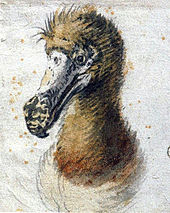 Painting of a dodo head by Cornelis Saftleven from 1638, which may be one of the last illustrations made of a live dodo
Painting of a dodo head by Cornelis Saftleven from 1638, which may be one of the last illustrations made of a live dodo
Several contemporary sources state that the dodo used gizzard stones. The English historian Sir Hamon L'Estrange, who witnessed a live bird in London in 1638, described it as such:
The keeper called it a Dodo, and in the ende of a chymney in the chamber there lay a heape of large pebble stones, whereof hee gave it many in our sight, some as big as nutmegs, and the keeper told us that she eats them (concucing to digestion), and though I remember not how far the keeper was questioned therein, yet I am confident that afterwards she cast them all again.[27]
The tambalacoque, also known as the "dodo tree", was hypothesized by Stanley Temple to have been eaten from by dodos, and only by passing through the digestive tract of the dodo could the seeds germinate; he claimed that the tambalacocque was now nearly extinct due to the dodo's disappearance. He force-fed seventeen tambalacoque fruits to wild turkeys and three germinated. Temple did not try to germinate any seeds from control fruits not fed to turkeys so the effect of feeding fruits to turkeys was unclear. Temple also overlooked reports on tambalacoque seed germination by A. W. Hill in 1941 and H. C. King in 1946, who found the seeds germinated, albeit very rarely, without abrading.[28][29][30][31]
Extinction
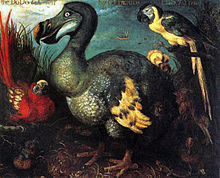 One of the most famous and often copied paintings of a dodo specimen, as painted by Roelant Savery in 1626. The image came into the possession of the ornithologist George Edwards, who later gave it to the British Museum[32]
One of the most famous and often copied paintings of a dodo specimen, as painted by Roelant Savery in 1626. The image came into the possession of the ornithologist George Edwards, who later gave it to the British Museum[32]
As with many animals that have evolved in isolation from significant predators, the dodo was entirely fearless of people, and this, in combination with its flightlessness, made it easy prey for humans.[33] However, journals are full of reports regarding the bad taste and tough meat of the dodo, while other local species such as the Red Rail were praised for their taste. When humans first arrived on Mauritius, they also brought with them other animals that had not existed on the island before, including dogs, pigs, cats, rats, and Crab-eating Macaques, which plundered the dodo nests, while humans destroyed the forests where the birds made their homes;[34] the impact these animals—especially the pigs and macaques—had on the dodo population is currently considered to have been more severe than that of hunting. The 2005 expedition's finds are apparently of animals killed by a flash flood; such mass mortalities would have further jeopardized a species already in danger of becoming extinct.[35]
Although there are scattered reports of mass killings of dodos for provisioning of ships, archaeological investigations have hitherto found scant evidence of human predation on these birds. Some bones of at least two dodos were found in caves at Baie du Cap which were used as shelters by fugitive slaves and convicts in the 17th century, but due to their isolation in high, broken terrain, were not easily accessible to dodos naturally.[36]
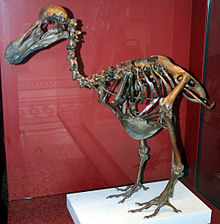 Cast of a dodo skeleton put together from bones found in a marshy pool on Mauritius, Natural History Museum
Cast of a dodo skeleton put together from bones found in a marshy pool on Mauritius, Natural History Museum
There is some controversy surrounding the extinction date of the dodo. Roberts & Solow state that "the extinction of the Dodo is commonly dated to the last confirmed sighting in 1662, reported by shipwrecked mariner Volkert Evertsz" (Evertszoon), but many other sources suggest the more conjectural date of 1681. Roberts & Solow point out that because the sighting prior to 1662 was in 1638, the dodo was likely already very rare by the 1660s, and thus a disputed report from 1674 cannot be dismissed out-of-hand.[37] Statistical analysis of the hunting records of Isaac Johannes Lamotius give a new estimated extinction date of 1693, with a 95% confidence interval of 1688 to 1715; the last reported sighting is from the hunting records of Isaac Johannes Lamotius, who gives the year 1688, but it has been suggested that by this time the Dutch name "dodaers" had been transferred to the flightless Red Rail, which is now also extinct.[38] Considering more circumstantial evidence such as travelers' reports and the lack of good reports after 1689,[36] it is likely that the dodo became extinct before 1700; the last dodo died a little more than a century after the species' discovery in 1581.[39]
Cultural significance
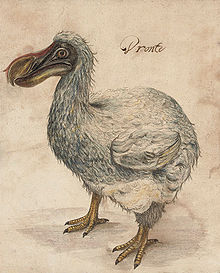 In 2009 a previously unpublished 17th century Dutch illustration of a dodo went for sale at Christie's.
In 2009 a previously unpublished 17th century Dutch illustration of a dodo went for sale at Christie's.
The dodo's significance as one of the best-known extinct animals and its singular appearance has led to its use in literature and popular culture to symbolize a concept or object that will or has become out of date, as in the expression "dead as a dodo" or "gone the way of the dodo".[40][41] In the same year in which George Clarke started to publish his reports, the newly vindicated bird was featured as a character in Lewis Carroll's Alice's Adventures in Wonderland. With the popularity of the book, the dodo became a well-known and easily recognizable icon of extinction.[42]
In 2009 a previously unpublished 17th century Dutch illustration of a dodo went for sale at Christie's, and was expected to sell for £6,000.[43] It was sold for £44,450.[44]
The dodo is used by many environmental organizations that promote the protection of endangered species, such as the Durrell Wildlife Conservation Trust and the Jersey Zoological Park, founded by Gerald Durrell.[45]
The dodo rampant appears on the coat of arms of Mauritius.[34]
See also
References
- ^ "The Oxford Dodo". Learning More. The Oxford University Museum of Natural History. http://www.oum.ox.ac.uk/learning/pdfs/dodo.pdf. Retrieved 13 September 2011.
- ^ "Raphus cucullatus". IUCN Red List of Threatened Species. Version 2011.1. International Union for Conservation of Nature. 2008. http://www.iucnredlist.org/apps/redlist/details/143436. Retrieved 2011-08-09.
- ^ "Le Dodo". http://www.island-of-mauritius.com/dodo.htm. Retrieved 2011-11-17.
- ^ "The Dodo - Raphus Cuccullatus". http://www.tourism-mauritius.mu/discover/the-dodo.html. Retrieved 2011-11-17.
- ^ A trve report of the gainefull, prosperous, and speedy voiage to Iava in the East Indies, performed by a fleete of eight ships of Amsterdam: which set forth from Texell in Holland, the first of Maie 1598. Stilo Novo. Whereof foure returned againe the 19. of Iuly Anno 1599. in lesse thaen 15 moneths: the other foure went forward from Iava for the Moluccas[dead link]
- ^ Staub, France. "Le musée du Dodo". Potomitan. http://www.potomitan.info/dodo/c32.php. Retrieved 2009-01-18.
- ^ Rothschild, Walter (1907). Extinct Birds. London: Hutchinson & Co. p. 172. http://www.archive.org/download/extinctbirdsatte00roth/extinctbirdsatte00roth.pdf.
- ^ Staub, France (1996): Dodo and solitaires, myths and reality. Proceedings of the Royal Society of Arts & Sciences of Mauritius 6: 89-122 HTML fulltext
- ^ Strickland, H.E. (1848) The Dodo and its Kindred London: Reeve, Benham and Reeve. p.128
- ^ a b "Dodo skeleton find in Mauritius". BBC News (London). 2006-06-24. http://news.bbc.co.uk/2/hi/science/nature/5113372.stm. Retrieved 2006-08-28.
- ^ The Portuguese word doudo or doido may itself be a loanword from Old English (cf. English "dolt").
- ^ Quammen, David (1996): The Song of the Dodo: Island Biogeography in an Age of Extinction. Touchstone, New York. ISBN 0-684-82712-3
- ^ Shapiro, Beth; Sibthorpe, Dean; Rambaut, Andrew; Austin, Jeremy; Wragg, Graham M.; Bininda-Emonds, Olaf R. P.; Lee, Patricia L. M. & Cooper, Alan (2002): Flight of the Dodo. Science 295: 1683. doi:10.1126/science.295.5560.1683 (HTML abstract) Free PDF Supplementary information
- ^ See Raphidae as for why the date "25 mya" is suspect
- ^ "DNA yields dodo family secrets". BBC News (London). 2002-02-28. http://news.bbc.co.uk/2/hi/science/nature/1847431.stm. Retrieved 2006-09-07.
- ^ Johnson, Kevin P. and Dale H. Clayton (2000): Nuclear and Mitochondrial Genes Contain Similar Phylogenetic. Signal for Pigeons and Doves (Aves: Columbiformes). Molecular Phylogenetics and Evolution 14(1): 141–151. PDF fulltext
- ^ Kitchener A.C., "Justice at last for the dodo", New Scientist p.24, 28 August 1993.
- ^ Kitchener, A. On the external appearance of the dodo, Raphus cucullatus. Archives of natural History, 20, 1993.
- ^ Dissanayake, Rajith (2004). "What did the dodo look like?". The Biologist (Society of Biology) 51 (3): 165–168. http://web.mac.com/rajith/rajith/About_Me_files/What%20did%20the%20dodo%20look%20like%3F.PDF. Retrieved 14 September 2011.
- ^ Hume, Julian P. (2006). "The history of the Dodo Raphus cucullatus and the penguin of Mauritius". Historical Biology 18 (2): 65–89. doi:10.1080/08912960600639400. ISSN 0891-2963. http://julianhume.co.uk/wp-content/uploads/2010/07/History-of-the-dodo-Hume.pdf. Retrieved 14 September 2011.
- ^ Hume, Julian P. (2006). "Unpublished drawings of the Dodo Raphus cucullatus and notes on Dodo skin relics". Bull. B. O. C. 126A: 49–54. ISSN 0007-1595. http://julianhume.co.uk/wp-content/uploads/2010/07/Hume-et-al-dodo-skin-relics.pdf. Retrieved 14 September 2011.
- ^ "Scientists find 'mass dodo grave'". BBC News (London). 2005-12-24. http://news.bbc.co.uk/2/hi/science/nature/4556928.stm. Retrieved 2006-09-07.
- ^ "Dodo Skeleton Found on Island, May Yield Extinct Bird's DNA". National Geographic. 2007-07-03. http://news.nationalgeographic.com/news/2007/07/070703-dodo.html. Retrieved 2007-07-09.
- ^ Rothschild, Walter (1907). Extinct Birds. London: Hutchinson & Co. pp. 176, Plate 25. http://www.archive.org/download/extinctbirdsatte00roth/extinctbirdsatte00roth.pdf.
- ^ Cheke, Anthony S. and Julian Pender Hume. "The white dodo of Réunion Island". http://julianhume.co.uk/wp-content/uploads/2010/07/Hume-and-Cheke-no-illustrations.pdf. Retrieved 2009-01-18.
- ^ http://julianhume.co.uk/wp-content/uploads/2010/07/new-discoveries.pdf
- ^ Fuller, Errol (2001). Extinct Birds (revised ed.). Comstock. ISBN 080143954X., pp. 96–97
- ^ Temple, Stanley A. (1977): Plant-animal mutualism: coevolution with Dodo leads to near extinction of plant. Science 197(4306): 885-886. HTML abstract
- ^ Hill, A. W. (1941): The genus Calvaria, with an account of the stony endocarp and germination of the seed, and description of the new species. Annals of Botany 5(4): 587-606. PDF fulltext (requires user account)
- ^ King, H. C. (1946). Interim Report on Indigenous Species in Mauritius. Government Printer, Port Louis, Mauritius.
- ^ Witmer, M. C. & Cheke, A. S. (1991): The dodo and the tambalacoque tree: an obligate mutualism reconsidered. Oikos 61(1): 133-137. HTML abstract
- ^ Stuart Mason, A. (1992) George Edwards: the bedell and his birds. London: Royal College of Physicians p.47
- ^ "Scientists pinpoint dodo's demise". BBC News (London). 2003-11-20. http://news.bbc.co.uk/2/hi/science/nature/3281323.stm. Retrieved 2006-09-07.
- ^ a b Jonathan Fryer (2002-09-14). "Bringing the dodo back to life". BBC News (London). http://news.bbc.co.uk/2/hi/programmes/from_our_own_correspondent/2255991.stm. Retrieved 2006-09-07.
- ^ Tim Cocks (2006-06-04). "Natural disaster may have killed dodos". Reuters. http://www.abc.net.au/science/news/ancient/AncientRepublish_1678225.htm. Retrieved 2006-08-30.
- ^ a b Janoo, Anwar (2005): Discovery of isolated dodo bones [Raphus cucullatus (L.), Aves, Columbiformes] from Mauritius cave shelters highlights human predation, with a comment on the status of the family Raphidae Wetmore, 1930. Annales de Paléontologie 91: 167–180. [English with French abstract] DOI:10.1016/j.annpal.2004.12.002 (HTML abstract) Hume et al. ref probably too.
- ^ Roberts, David L. & Solow, Andrew R. (2003): Flightless birds: When did the dodo become extinct? Nature 425(6964): 245. doi:10.1038/426245a (HTML abstract)
- ^ http://julianhume.co.uk/wp-content/uploads/2010/07/Nature-10-June-2004-Dodo-paper.pdf
- ^ Dodo Bird FAQs - WikiFAQ - Answers to Frequently Asked Questions (FAQ)
- ^ Steve Miller (2006-09-25). "First The Dodo, Now Full-Size SUV". Brand Week. Archived from the original on September 27, 2007. http://web.archive.org/web/20070927045754/http://www.brandweek.com/bw/news/recent_display.jsp?vnu_content_id=1003156227. Retrieved 2006-09-26.
- ^ "Water ford Wildlife". Water ford Today. 2006-01-01. http://www.waterford-today.ie/index.php?id=19474&what=2&issue=320. Retrieved 2006-09-26.
- ^ Mayell, Hillary (2002-02-28). "Extinct Dodo Related to Pigeons, DNA Shows". National Geographic News. http://news.nationalgeographic.com/news/2002/02/0227_0228_dodo.html. Retrieved 2009-01-19.
- ^ Jamieson, Alastair (2009-06-22). "Uncovered: 350-year-old picture of dodo before it was extinct". The Daily Telegraph (London). http://www.telegraph.co.uk/culture/art/art-news/5596737/Uncovered-350-year-old-picture-of-dodo-before-it-was-extinct.html.
- ^ http://www.christies.com/LotFinder/lot_details.aspx?intObjectID=5224172
- ^ Dee pa Unhook (2006-09-26). "Mauritius: Footprints From the Past". expresser's. http://allafrica.com/stories/200609260428.html. Retrieved 2006-09-26. (requires subscription)
External links
Categories:- IUCN Red List extinct species
- Extinct flightless birds
- Species made extinct by human activities
- National symbols of Mauritius
- Raphinae
- Bird extinctions since 1500
- Onomatopoeias
- Birds of Mauritius
- Animals described in 1758
Wikimedia Foundation. 2010.



